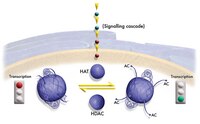DNA replication cycle in parthenogenetically developing eggs of the starfish Asterina pectinifera.
A Nomura,S Nemoto
Development, growth & differentiation
40
1998
Show Abstract
Starfish oocytes artificially activated by a calcium ionophore will develop normally if the formation of polar bodies is suppressed. In the present paper, schedules of the DNA replication period (S phase) of these parthenogenotes were explicitly timed using 5-bromo-2'-deoxyuridine (BrdU) and anti-BrdU monoclonal antibody. Their schedule of S phase was identical to that of fertilized eggs. Consequently, an S phase regulation system is triggered even in parthenogenotes raised by dual treatment of egg activation and polar body suppression. The S phase schedule of parthenogenotes confirms the temporal pattern of chromosome duplication, observed by other researchers, leading to tetraploid parthenogenotes. The S phase determination also provides a basis for argument concerning the number of centrioles participating in parthenogenetic development. If polar body formation of activated eggs was not suppressed, the first S phase was normal, but the second S phase did not recur on time. A rigidly regulated system of DNA replication cycle, which should be an essential prerequisite for parthenogenesis, thus requires the content of polar bodies. | 9727351
 |

















